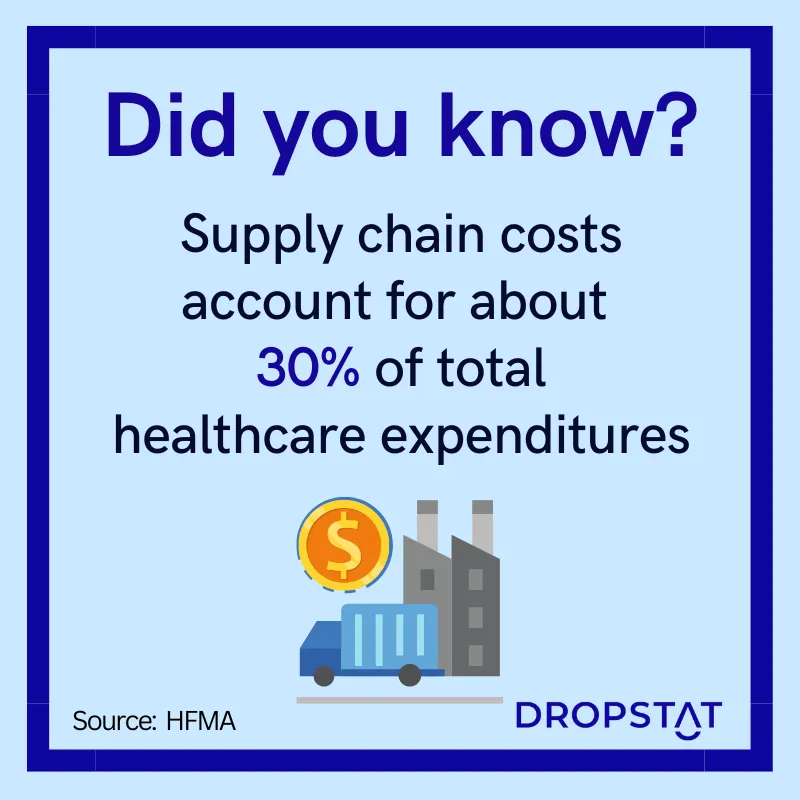What is supply chain management in healthcare?
The healthcare supply chain is an extensive network of systems, components, and processes that are collectively responsible for delivering every item necessary for a healthcare facility and individual healthcare providers to function. This means obtaining resources, managing supply and demand levels, and delivering healthcare goods and services to the right place at the right time.
What is the purpose of supply chain management in healthcare?
Productive supply chain management systems enable healthcare institutions to utilize their resources more efficiently, thereby reducing excess costs and waste. Furthermore, healthcare supply chain management aims to pinpoint areas for improvement within supply chains between manufacturers, distributors, healthcare providers, and patients, which reduces healthcare costs, improves patient outcomes, and promotes value-based care.
Leveraging technology such as healthcare data analytics through supply chain management also enables facilities to allocate resources more effectively and identify savings opportunities, as well as demand forecasting. In addition, digitally tracking inventory through location-based data or integrating with electronic health records, for example, allows institutions to be better equipped for their patient volumes and demands. In turn, these practices work to create a more resilient healthcare supply chain to meet stakeholders’ standards.

Logistics and supply chain management in healthcare
Logistics are a key component of supply chain operations and require the coordination of numerous entities. The four aspects of the healthcare supply chain include:
Manufacturers
Manufacturers acquire materials required to develop products and assess the availability of resources in relation to population demands.
Distributors
Wholesale distributors transport products to providers from manufacturers and ensure that fragile materials are delivered safely. Furthermore, third-party providers assist distributors by transporting products locally.
Providers
Hospitals, pharmacies, urgent care centers, skilled nursing facilities, assisted living facilities, and long-term care facilities are all considered providers within the healthcare supply chain. Providers play a key role in supply chains by communicating with distributors to relay the needs and detect scarcities in inventory.
Patients
Consumers or patients in healthcare drive the demand for specific medical supplies and medication within health systems. They play a strategic part in determining which products are considered to be essential supplies and help steer the direction of healthcare supply chains.

5 basic components of healthcare supply chains
The different stages of supply chain operations assist healthcare systems in gaining insight into inventory management, including medical devices, personal protective equipment, and medication. The five stages involve:
1. Planning
The first stage of the healthcare supply chain process, “planning,” requires special attention to detail as well as providing an overview of a product from supply procurement to its delivery to providers and consumers.
2. Sourcing
Sourcing involves identifying and gathering the materials and services that are needed to manufacture a product. In addition, sourcing requires creating contracts with sellers and monitoring fulfillment.
3. Making/Producing
After creating an action plan and gathering the necessary material, the next step in the supply chain is referred to as “making”. This stage includes deciding on a schedule for executing the essential activities to create a functional product.
4. Delivering
Not only does delivery involve transporting products, but it also entails deciding on delivery methods depending on the product and any unique handling requirements.
5. Returning
Lastly, the stage of “returning” includes replacing defective orders in a timely fashion as well as processing the returns and quality of the product. This process also involves authorizing refunds and recording refunds along with tracking products that may no longer be manufactured.
The most common healthcare supply chain management challenges
Given the complex logistics of healthcare supply chains and the relationship between manufacturers, distributors, providers, and patients, supply chains may face challenges that involve data shortages and poor data analytics, manufacturing and delivery delays, and excess costs. Data silos and shortages occur when there is insufficient data or when adequate data has been collected but are only available to specific parts of a team or institution. This leads to a lack of data-informed decisions, contributing to excess costs, lost revenue, and manufacturing delays.
Additionally, as seen throughout the COVID-19 pandemic, manufacturing and delivery delays may result from a lack of materials, workforce, and issues with transporting goods. Consequently, this makes it more difficult to meet the market’s demands and leaves patients and providers in vulnerable situations where they may lack vital medical supplies.
Another challenge that healthcare supply chains face is excess costs that occur when supply chains overlook expenses associated with training, machine maintenance, upgrading outdated equipment, and other related issues. These expenses are often ignored in the initial assessment of the healthcare supply chain. However, they increase the overall cost of supply chain operations. Therefore, it is crucial to account for these issues when allocating funds.

4 healthcare supply chain solutions
Given that patient outcomes and healthcare efficiency are affected by healthcare supply chain management, optimizing your supply chain systems will lead to greater patient safety, higher patient satisfaction ratings, and a reduction in healthcare costs. Some methods that can be used to improve supply chains within healthcare include:
- Creating effective inventory management systems
- Utilizing data to plan for demand forecasting
- Considering all operating costs
- Maintaining effective communication with manufacturers and distributors
1. Create effective inventory management systems
Effective inventory management techniques enable healthcare facilities to reduce excess spending on supplies and equipment while offering greater transparency into supply chain operations. This enables your supply chain to track supplies and reduce the risk of overselling products, which leads to cost savings opportunities and well-organized operations. This also decreases the likelihood of wasted medical supplies.
2. Utilize data to plan for demand forecasting
Take advantage of your supply chain data to allow your healthcare facility to take part in more reliable demand forecasting. This gives your facility the ability to plan for future supply needs and determine potential revenue. In addition, demand forecasting allows your facility to establish more realistic strategic planning goals using previous supply data while positioning your institution for maximum profit.
3. Consider all operating costs
While some components of supply chain operations are obvious, others are easily overlooked, which contributes to costs that may not have been accounted for. One way to increase transparency and reduce healthcare costs in your supply chain is to increase automation throughout the process. This decreases the need for third parties and helps streamline basic tasks, ultimately improving efficiency. Furthermore, this practice helps healthcare facilities mitigate excess costs related to managing operations regarding training and maintenance.
4. Maintain effective communication with manufacturers and distributors
Lastly, prioritizing communication between all components of the healthcare supply chain helps ensure that stakeholders’ needs are met and that responsibilities, expectations, and goals are clearly understood between all parties involved. Additionally, effective communication strategies help healthcare supply chains avoid potential disruptions that may lead to poor health outcomes. Often, these negative outcomes result from a lack of access to necessary medical supplies and equipment, as well as a lack of trust between the different supply chain entities. Ultimately, this creates a more collaborative team that supports a patient-centered healthcare system through efficient operations.
Conclusion
Proper healthcare supply chain management can positively affect healthcare operations, whether it is reducing costs, accurately predicting future demand, or ensuring that care quality and patient outcomes are supported through sufficient medical supplies and equipment. Focusing on supply chain management not only helps determine weaknesses within your healthcare supply chain but also enables your facility to distribute resources more effectively, leading to more efficient healthcare practices and greater value-based care.







